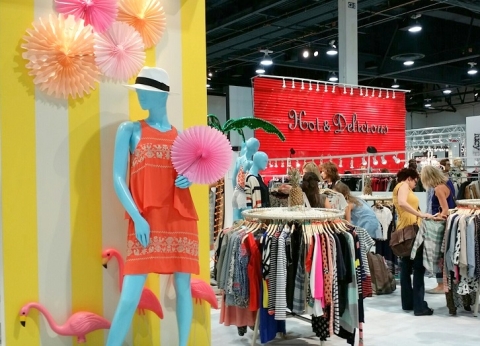MAGIC Market Week Up in Attendance, Square Footage and Buyers on 1 Million-plus Net Sq. Ft. Showfloor

MAGIC Market Week brought the passion for fashion Aug. 19-21 to the Las Vegas Convention Center and Mandalay Bay Convention Center.
Advanstar Global’s biannual trade show is comprised of 10shows that cover everything from apparel to swimwear and footwear. This summer’s event spanned a little more than 1 million net square feet, showcased about 5,000 exhibitors and attracted about 70,000 attendees.
“We’re up from February across the board in attendance and square footage,” said Christopher Griffin, president of WWDMAGIC and Sourcing. “We’re also up in the high-single to low-double digits in buyers on the floor.”
Griffin attributed the strong numbers to the apparel industry feeling optimistic about the fourth quarter and the upcoming holiday season. But there’s also been a lot of work done by the show to keep those numbers up.
“We’ve been spending a lot of time in Europe and Japan promoting our brand,” Griffin said. Last July, WWDMAGIC shared a booth with Project at Japan Fashion week.
Now, the show sports a growing Japanese contingent. The show’s presence at Prêt à Porter Paris and Who’s Next was instrumental in scoring relationships with Bestseller, one of top European fast fashion retailers.
“Working with a foreign brand is a risk for a boutique, but people have a thirst for newness,” Griffin said. “There’s cache in saying this is a line from Tokyo.”
European and Asian brands see the U.S. market in rebound mode, and Griffin said he expects their numbers to continue growing at MAGIC. “We’re at 80/20 right now, but I see us moving towards 70/30 in the next two years across all categories,” he said.
The allure is not so much their exhibit square footage, but the international flare that they bring to the show, piquing buyers’ interest and making the show a place “where the world comes together.”
At Sourcing, the attention is shifting away from China and on to other regions, as brands continue to diversify their supply chains and look for near-shoring and “Made in USA” opportunities.
“This show we’ve got 30 booths from Mexico, compared to three at the last show,” Griffin said. Indonesia and Vietnam, among others, had pavilions.
Andean Community countries, including Colombia and Peru, had a strong floor presence and also were represented on several panels. Ethiopia and Kenya exhibited for the first time.
For February 2015, Griffin said he hopes to get a North Carolina pavilion to showcase the state’s textile industry at Sourcing. He also hopes to grow the machinery part of Sourcing, considering the demand for high-tech equipment by domestic manufacturers.
When asked about whether the shows are eyeing the additional square footage that will soon be available at Mandalay Bay Convention Center, Griffin said, “We’d love to take advantage of it. If it does expand, it will be nice for us to have options.”
Griffin’s strategy to market at foreign shows had a direct impact on the first-time exhibitor Baltic Sewing from Kaunus, Lithuania.
“We saw a commercial about Sourcing at Première Vision in Paris and decided to test it out this year,” said Marketing Director Kestutis Pauza. The company has been working mainly with European designers but is hoping the show will help them break into the U.S. market.
Attendee Michael Cooper with Clothes Expressions in Florida was gearing up for the busy winter season. As his wife was scouting accessories, he was making his way through country club women’s fashions.
“We’re having a very good show,” he said. “But it would have been easier if all sportswear brands were in one place.”


Add new comment